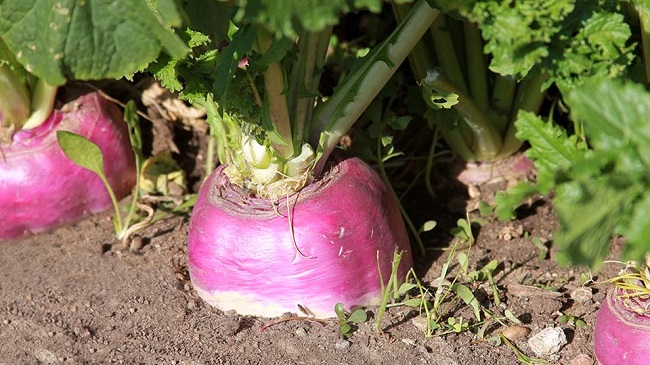Turnips have a long history and have been cultivated for centuries. They are believed to have originated in central and eastern Asia and were likely first domesticated in the Middle East. From there, they spread to Europe and eventually to the Americas.

The ancient Greeks and Romans grew turnips and used them for both food and medicine. In medieval times, turnips were a staple food in Europe and were commonly grown in vegetable gardens. They were used as a cheap and filling food source for peasants and were often roasted, boiled, or mashed.
During the 18th and 19th centuries, turnips became an important crop for livestock feed in Europe and North America. In the United States, turnips were grown extensively in the southern states, where they were used to feed pigs and other livestock.
Today, turnips are still grown around the world and are used in a variety of cuisines. They are a versatile vegetable and can be roasted, boiled, mashed, or used in stews and soups. Turnip greens are also popular and are used in many Southern-style dishes. Additionally, turnips are high in nutrients, such as vitamin C, fiber, and potassium, making them a healthy addition to any diet.
Nutritional Value of Turnips
Turnips are a nutrient-dense vegetable that offer a range of health benefits. Here are some of the key nutritional values of turnips:
Low Calories: A medium-sized turnip (about 4 ounces) contains around 34 calories.
Fiber: Turnips are a good source of fiber, with around 2 grams per serving. Fiber is important for digestive health and can help reduce the risk of heart disease, diabetes, and certain types of cancer.
Vitamin C: Turnips are rich in vitamin C, which is important for immune system function, skin health, and wound healing.
Potassium: Turnips are a good source of potassium, with around 230 milligrams per serving. Potassium is important for maintaining healthy blood pressure and can help reduce the risk of stroke, heart disease, and kidney stones.
Calcium: Turnips are also a good source of calcium, with around 50 milligrams per serving. Calcium is important for strong bones and teeth.
Vitamin K: Turnips contain vitamin K, which is important for blood clotting and bone health.
In addition to these nutrients, turnips also contain antioxidants and other beneficial compounds that may help reduce inflammation, improve heart health, and protect against certain types of cancer. Overall, turnips are a healthy and nutritious addition to any diet.
How to Grow Turnips
Turnips are a cool season crop that can be grown in both the spring and fall. They are relatively easy to grow and can be grown in a variety of soil types. Here are the basic steps for growing turnips:
Planting Location
Turnips grow best in a sunny location with well-draining soil. They prefer soil that is rich in organic matter and has a pH of 6.0 to 7.5.
Prepare the Soil
Before planting, loosen the soil to a depth of at least 6 inches and amend with compost or other organic matter. This will help improve soil fertility and drainage.
Planting
Sow turnip seeds directly into the soil, spacing them about 1 inch apart and 1/4 inch deep. Rows should be spaced about 12 inches apart. Cover the seeds with soil and gently firm the soil.
Watering
Water the seeds immediately after planting and keep the soil moist until the seeds germinate. Once the plants are established, water them deeply once a week or more often if the weather is dry.
Thin the Seedlings
Once the seedlings have emerged, thin them to about 4 to 6 inches apart. This will allow the turnips to have enough space to grow and develop properly.
Fertilizer
Apply a balanced fertilizer once a month to provide the turnips with the nutrients they need to grow.
Harvesting
Turnips can be harvested when they are about 2 to 3 inches in diameter, which usually takes around 50 to 60 days. Simply pull them out of the ground and remove the leaves before storing.
By following these steps, you can grow your own turnips and enjoy their delicious and nutritious flavor in your meals.
10 Fun Facts About Turnips
Turnips were one of the first vegetables to be cultivated by humans, dating back to prehistoric times.
In ancient times, turnips were used not only for food but also as medicine and as a source of lamp oil.
Turnips were once considered a poor man’s food, but they have since become a popular ingredient in many gourmet dishes.
Turnips come in a variety of colors, including white, yellow, and purple.
Turnips are a cruciferous vegetable, which means they are related to other healthy vegetables like broccoli, cauliflower, and kale.
The largest turnip on record weighed over 37 pounds and was grown in the UK in 2016.
Turnips were used as a form of currency in ancient times, particularly in Scotland and Ireland.
The leaves of turnips, known as turnip greens, are also edible and contain high levels of nutrients like vitamin A, vitamin C, and calcium.
Turnips are used in many traditional dishes around the world, including the popular Scottish dish “neeps and tatties” (turnips and potatoes).
Turnips were once thought to have magical properties and were used in various folk remedies to ward off evil spirits or to cure ailments like headaches and coughs.
Related Articles & Free Email Newsletter Sign Up
Cucumbers are Cool, Refreshing and Loaded with Health Benefits
How to Grow Fresh Salad Greens



Comment here